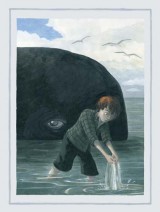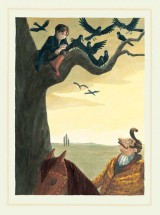Bambert's Book of Missing Stories can help children to appreciate the powerful effects of reading and writing...
Some books are treasured gifts that should be shared and delighted in and then passed on and on. Bambert’s Book of Missing Stories is one such treasure. This profound and haunting tale tells the story of Bambert who lives a reclusive life in his own world of stories. Suffering physically since childhood, he detaches himself from everyday life, preferring to live alone in his attic home. Only Mr Bloom, the grocer who runs the shop below, and a daily newspaper keep him in touch with the outside world. But Bambert is not alone. He is a reader and writer of stories.
As we learn of Bambert’s life, we find he has written in his Book of Wishes ten very special stories and has room for just one more. Desperate that his final story should be true and suddenly aware that his other stories – never seen or read by anyone else – are frozen in the Book of Wishes, he decides to set them free into the world. He tears up the Book of Wishes into eleven separate parts and removes any mention of where the stories take place so they might find new and real settings out in the world. He then sends the stories off into the night, held by eleven Japanese paper balloons, and waits for their return.
Slowly his stories come back to him, seemingly from all over Europe, each with its own special and unusually appropriate setting. Through Bambert’s eyes we experience each amazing story. It is through the stories we learn of his profound perceptions of the world and his desire to undo some of the suffering he sees. Often sad, sometimes disturbing, though with a thread of hope, the tale leads us to the final unwritten story, which eventually returns, but not quite as we expect.
Naturally this treasure provides a wealth of opportunities for children to delight in and learn from as they enter Bambert’s world and explore the stories with him and each other.
Bambert considers himself an outsider, set apart from a world where he believes he doesn’t really fit in. Physically different from those around him because of his unusually short stature and scarred by suffering and pain as a child, he fears what others may think of him and so chooses the life of a recluse.
Explore with the children their own initial thoughts and feelings about Bambert using the book’s illustrations. The book is beautifully illustrated by Emma Chichester Clark who paints a dark and atmospheric picture of Bambert’s world. There are two images of Bambert seated in his specially adapted chair looking out through his attic window into the world.
• What are children’s initial thoughts about his physical appearance?
• From the image of him alone in his attic room chair, how do they think he feels? Create a freeze frame of the scene and thought track Bambert as he looks out on the stars.
• What job do they think he does? Who do they think he lives with? Where do they think he lives?
• Bambert believes that if he goes out of his house adults will pity him and children will laugh at him. Do the children think this will happen? If so why?
• Have the children themselves ever felt self conscious, different or that they do not fit in?
• Sometimes our fear of what people will think of us can stop us doing things we want to. Has that ever happened to any of the children?
• Do they think Bambert is lonely?
 Ask the children to discuss what they think this description of Bambert means.“Bambert felt like a ship wrecked mariner cast up on hostile shores on the far side of a dream. This world was purgatory to him. Over there on the other side was his lost paradise.”
Ask the children to discuss what they think this description of Bambert means.“Bambert felt like a ship wrecked mariner cast up on hostile shores on the far side of a dream. This world was purgatory to him. Over there on the other side was his lost paradise.”
Develop a class ‘role on the wall’ drawing an outline of Bambert. Outside the outline begin to add all the things they know about him, questions they might like to know or things they are not sure about. Within the outline use two different colours, one to note how Bambert feels about himself and a second to add words to illustrate how they would describe Bambert’s character. This activity can be ongoing as the children continue to explore the story.
Although physically unable to travel, we find that Bambert could ‘travel through space and time as no one had ever done before.’ How? Through the power of story.
We find that he has a library of over a thousand books and has read every one and so has seen and explored the world through the eyes of poets and writers. As a writer himself he has transported himself into other worlds and created characters and wishes to help him understand the world.
 • Explore with the children what it means for them to be a reader. Which books have meant a lot to them and why? Which ones do they remember well? Which are their favourites? Are there any books that have taught them something special? Which is the most exciting place they have been to in a story?
• Explore with the children what it means for them to be a reader. Which books have meant a lot to them and why? Which ones do they remember well? Which are their favourites? Are there any books that have taught them something special? Which is the most exciting place they have been to in a story?
• What does it mean to be a writer? What does writing mean to them personally? Bambert reads about the suffering in the world in the daily newspaper and feels useless but uses his stories to express how he feels about that suffering. What do the children like to write about?
• Often writers use journals to jot down thoughts, feelings and ideas which interest them or affect them or to record things they notice or observe in everyday life. Introduce the idea of a writing journal to the children. Let them decorate the journal and try to give them time during the week when they can reflect and use them to gather ideas for writing. My Name is Mina by David Almond is a great example of a fictional writing journal to explore with a class.
As a teacher I’m always on the look out for excellent short stories beautifully written and packed with interesting themes. They are often more easily managed in terms of planning and holding the whole class’ interest.
Within this amazing book of course we have eleven such stories. Although bound together within the tale of Bambert, they each individually represent a wealth of depth and discovery to engage and provoke thought with children.
• It is advisable to read the stories carefully first as some should perhaps be explored as a whole class together, such as The Strange Game with its theme of the futility and devastating effect of war. The role of children and the hope they can bring flows through many of Bambert’s stories, including this one, and already I want to leap off and discuss The Kites are Flying by Michael Morpurgo or Whadayamean by John Burningham to further explore children’s perceptions of war and hope. Another of the stories to read together would be The Glass Rafts, a stark and moving story about concentration camps which returns to Bambert with a Polish setting.
 • Some stories the class could explore in smaller groups. Give children a framework to stimulate discussion and thinking. Aiden Chambers’ Three Sharings are a great place to start. Share children’s enthusiasms – what did they like or dislike? Share their puzzles – what didn’t they understand or what did a particular part mean? And share their connections – what did the story bring to mind? A thought, a memory, a reminder of something that has happened to them or they have seen in another book, film or situation? Encourage response and critical thinking rather than ‘the right answer’ as children discuss what they think the theme of the story might be. What are Bambert’s reflections and thoughts on the ‘new’ story? Split the class into groups and each explore one of the stories in the same way and present back to the class. Each group may want to retell the story first, perhaps through drama or a freeze frame of a scene from the story.
• Some stories the class could explore in smaller groups. Give children a framework to stimulate discussion and thinking. Aiden Chambers’ Three Sharings are a great place to start. Share children’s enthusiasms – what did they like or dislike? Share their puzzles – what didn’t they understand or what did a particular part mean? And share their connections – what did the story bring to mind? A thought, a memory, a reminder of something that has happened to them or they have seen in another book, film or situation? Encourage response and critical thinking rather than ‘the right answer’ as children discuss what they think the theme of the story might be. What are Bambert’s reflections and thoughts on the ‘new’ story? Split the class into groups and each explore one of the stories in the same way and present back to the class. Each group may want to retell the story first, perhaps through drama or a freeze frame of a scene from the story.
• Bambert removes the original settings from each story and, when they return, each has a new setting based on where they appear to have landed by balloon. The first, for example, has ended up in Donegal Bay in Ireland as the return stamp indicates and so Bambert rewrites the story set in Ireland and uses Irish names for the characters. Discuss the ideas of genre and setting. Use the Irish Eye of the Sea story and ask the children to rewrite the story choosing different countries as settings, would the story still work set on a beach off the Great Barrier Reef?
Before revealing the final unwritten missing story, give the children the opportunity to write their own final story for the book using its title, On the Far Side of the Dream.
• Towards the end of the book we realise the part that the grocer Mr Bloom has played in the life of Bambert. Without ruining the ending, the role of true friendship will be a key theme to explore.
We’ve only just lifted the lid on the treasure trove within this book. Open, explore and then pass it on!
Bambert’s Book of Missing Stories (Egmont Books, 2002, ISBN 978-1-4052-5435-9) is written by Reinhardt Jung and illustrated by Emma Chichester Clark.
Use these ideas to inspire learning in other subjects…
• Create a display map highlighting the countries, cities and rivers of Europe where each story is set.
• Explore origami techniques and make your own Japanese paper balloon. Youtube has some excellent video demonstrations. Add them to your display map.
• Collect and display examples of foreign stamps - discover the stamp collectors amongst your parents.
• Design and make a parachute in science to support a tea-light. What size will you need and what material would be best?
Easy ways to combat teacher stress
Ace-Heads
How children react to a moral dilemma may be down to your teaching
Ace-Classroom-Support
